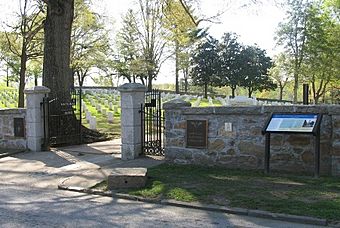Danville National Cemetery (Virginia) facts for kids
|
Danville National Cemetery
|
|

Entrance to the cemetery
|
|
| Location | 721 Lee St., Danville, Virginia |
|---|---|
| Area | 4 acres (1.6 ha) |
| Built | 1866 |
| Architectural style | Colonial Revival |
| MPS | Civil War Era National Cemeteries MPS |
| NRHP reference No. | 95000274 |
Quick facts for kids Significant dates |
|
| Added to NRHP | April 7, 1995 |
The Danville National Cemetery is a special place in Danville, Virginia. It is a United States National Cemetery, which means it's a burial ground for soldiers and veterans. The U.S. Department of Veterans Affairs takes care of it.
This cemetery covers about 3.5 acres (1.4 ha) of land. By the end of 2005, more than 2,200 people had been buried there. It is a quiet and important place to remember those who served their country.
A Look Back: The Cemetery's Beginning
The Danville National Cemetery was created a long time ago, on August 14, 1867. The government set aside about 2.6 acres (1.1 ha) for it. This was part of a bigger effort to honor soldiers who had died.
Most of the first people buried here were soldiers from the Union Army. They had been prisoners during the American Civil War. They were held in Danville, often in tobacco warehouses that were used as prisons.
Why Soldiers Were Buried Here
During the Civil War, many soldiers, including these prisoners, faced tough conditions. Sadly, many died from sickness and not having enough food. At first, these soldiers were buried in simple, unmarked graves.
Later, their remains were carefully moved and reburied. Each soldier was given their own marker. These brave soldiers came from many different states. Some were from Ohio, Illinois, Pennsylvania, and New York. Others were from Massachusetts, New Jersey, and Wisconsin.
The Danville National Cemetery is open to visitors all year. It is a place where people can come to learn about history. They can also pay their respects to the soldiers buried there.
The cemetery was recognized as an important historical site in 1995. It was added to the National Register of Historic Places.



